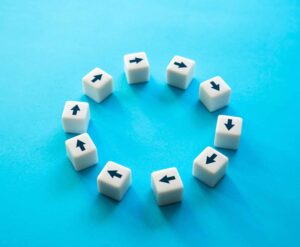Understanding the Cycle of Addiction
One of the worst ideas ever to be believed about substance abuse is that a person could “stop whenever they want to”. This is not because the entire concept is just a bad cliche, or that no one simply has the willpower to quit when they are into an addiction.
A substance abuse disorder requires a recovery process and not just the willingness to quit because of something called the addiction cycle, which almost certainly guarantees that a person who had an addiction will get back into it, even if they think they have gone completely clean.
What Is the Cycle of Addiction?
There are many different versions of the addiction cycle as used by therapists when explaining the process of how a person gets into an addiction. For purposes of simplicity, the most relatable form will be used to explain the addiction cycle.
The cycle of addiction begins when a person gets their first taste of the substance and experiences its effects. There are many cases where a person initially uses the substance purely for medicinal purposes, such as those who take prescription painkillers to help them deal with chronic pain. Many take stimulants to help them deal with particular conditions, such as attention-deficit hyperactivity disorder (ADHD).
In instances of alcohol abuse, the greatest likelihood of initial use is during a social event, where alcohol was prominently given to anyone who was at the event. Alcohol is a common fixture in most, if not all social events, whether it’s a family gathering, a school reunion, or even during events that are not considered celebrations, such as funerals.
In other instances, the intense pull of curiosity simply got the better of the person and they decided to see what the fuss was all about. Sadly, some substances could get a person hooked even only on the first try, such as the more potent stimulants. It also does not help that peer pressure often pushes young people to get into substance use at an early age.
The exact instance where a person slips into the abuse phase of the cycle is often a blurry memory for most, if not everyone, who has a substance abuse disorder. Heavy dependence could come swiftly for many who see the use of substances as a form of escape from some perceived problem they have, or from what they see as a dreary and uneventful life.
Many who were interviewed during their stay in a partial hospitalization program don’t remember when their addiction truly began. This could be due to several things, such as trauma, where the person tries everything to try to forget the horrors that they have seen or have been exposed to. In other cases, they could not remember because their cognitive functions have already been significantly affected by their substance abuse. A person’s memory is typically one of the first things to be affected when a person is heavily into substance abuse.
The abuse phase is typically the stage of the addiction cycle where the person usually experiences the desirable effects of the substance they use. In many cases, the damaging effects have not yet set in fully, or even if there are already some side effects present, they are still at a negligible level.
The tolerance phase of the addiction cycle is when the person begins to require a higher dosage of the substance they take. As the body is typically built to adapt to many things, the person could already be at a point where their body has already gotten used to the usual dosage of the substance they use, and to continue to feel the effects at the level they enjoy, they will now have to take more of it, or more frequently.
This phase is also part of the addiction cycle where the person could begin to entertain the notion of trying out even more potent substances, as they believe what they were using before does not serve them as well as it did. The tolerance creates a false sense of confidence in the person relevant to substance use, as they begin to believe that their body has developed an immunity to substances and they could take on stronger ones with no consequence.
When a person begins to develop a tolerance, many of them begin to manifest the behavioral patterns that lead to their isolation, such as irritability, belligerence, and unpredictable mood swings. This is due in part to the fact that they are getting increasingly frustrated that the substance is not giving them the same high as it used to.
The dependence phase of the addiction cycle is when the person has fully committed to the substance that they are using, with the person being fully convinced that they could not live another day without whatever it is that they are addicted to. At this stage of the cycle, the few moments of sobriety in between doses of the substance could prove to be extremely distressing to the person.
It should also be noted that many people could also foster a heavy dependence on a substance because they could simply not function without it. This is most evident in people who need potent painkillers to simply get through the day, as not taking their painkillers could leave them in debilitating pain.
There are also many instances where heavy dependence causes severe effects on the person when they do not get a fix on the substance they are addicted to. There are cases when people not on their substances begin to have seizures or convulsions, appearing as if they are going into a life-threatening situation without the use of their substance. This phase is also when the person stops caring if people know that they have an addiction, as they begin to use their substance in places or situations where they should not.
Once the person is fully immersed in a heavy dependence on the substance, they now have a full-blown addiction problem. It is next to impossible for people in this phase to curb the use of their substance, let alone consider going off it. Their full commitment to the substance becomes the sole center of their life, and they could simply not consider existence without it. Nothing else matters to the person at this phase, and it is not uncommon for people with a full-blown addiction to neglect or even leave the people who mean the most to them, such as a spouse or even offspring.
Although the person is already suffering from the damage caused by their substance abuse at this point, they will continue to give in to their addiction because it could be the only thing that they could think of or even have the vaguest notion about. It is not uncommon for people in this phase of the addiction cycle to be incoherent, unconsciously most of the time, or neglectful of the needful things in life such as eating and hygiene.
To people in this phase of the addiction cycle, the most they could think of apart from using their substance is where and when they could get their next fix of it. Many people with full-blown addiction could be found living in squalor in the most inhospitable areas just so they could be out of their minds all the time while they use their substances.
This part of the addiction cycle is perhaps the most crucial, as this is the point where people with a substance abuse disorder could be saved or be completely lost to the cycle. It is almost ironic to think that the phase where the person is already on their journey to recovery is also the time when they are most vulnerable to getting into substance abuse even more.
Following medical detox and outpatient rehab programs, a person in recovery will still feel the intense urges and cravings to get back to using substances again. Some admit that they wanted to use substances even more when they became sober again because they were in full command of their senses, and all of their senses appeared to be making the cravings even worse. This is because a person in the grip of a full-blown addiction is either numb or unconscious most of the time, and as such, they could not feel the things that are felt every day by people who do not use substances, such as pain, frustration, or anxiety.
Many people in relapse admit that they have become even weaker against the stress of everyday life than before they were into substance abuse because they already know the escape that being out of their minds could give. A person who is completely drunk or high could hardly be thought to experience the same thing as someone who is in full command of their senses and is aware of how troublesome everyday stress is. This is why most forms of mental health treatment are geared towards building emotional and mental strength against giving in to relapse while recovering.
Let 449 Recovery Show You the Key to Breaking the Addiction Cycle
 People often succumb to pitfalls not because they were mostly unaware of them. This is the same with a substance abuse disorder. People who don’t commit to understanding how the addiction cycle works are bound to repeat the same mistakes they made before. This could seriously damage their chances of achieving a lasting recovery from their dependence.
People often succumb to pitfalls not because they were mostly unaware of them. This is the same with a substance abuse disorder. People who don’t commit to understanding how the addiction cycle works are bound to repeat the same mistakes they made before. This could seriously damage their chances of achieving a lasting recovery from their dependence.
At 449 Recovery, our addiction treatment center in Mission Viejo, CA, our goal is to help you understand the addiction cycle better so that you are equipped with actionable knowledge to help you stay on the path to sobriety.

Dr. Warren Taff MD, graduated from the University of Birmingham, England School of Medicine, with a BA from Rutgers University. He then went on to UCLA School of Public Health in Los Angeles Health and Human Services and received an MPH. He also attended an internship in internal medicine, with the Veterans Administration. Dr. Taff’s residency includes General Psychiatry at USC, with elective residencies at the Royal Prince Alfred Hospital in Sydney, Australia, and Royal College of Psychiatry. Board certifications include American Board of Psychiatry and Neurology. Dr. Taff has extensive experience in both psychiatry and addiction medicine, extending from 1979 to present. He has held professional titles that include Chief of Staff and Medical Directorship in both hospitals and private sectors.






